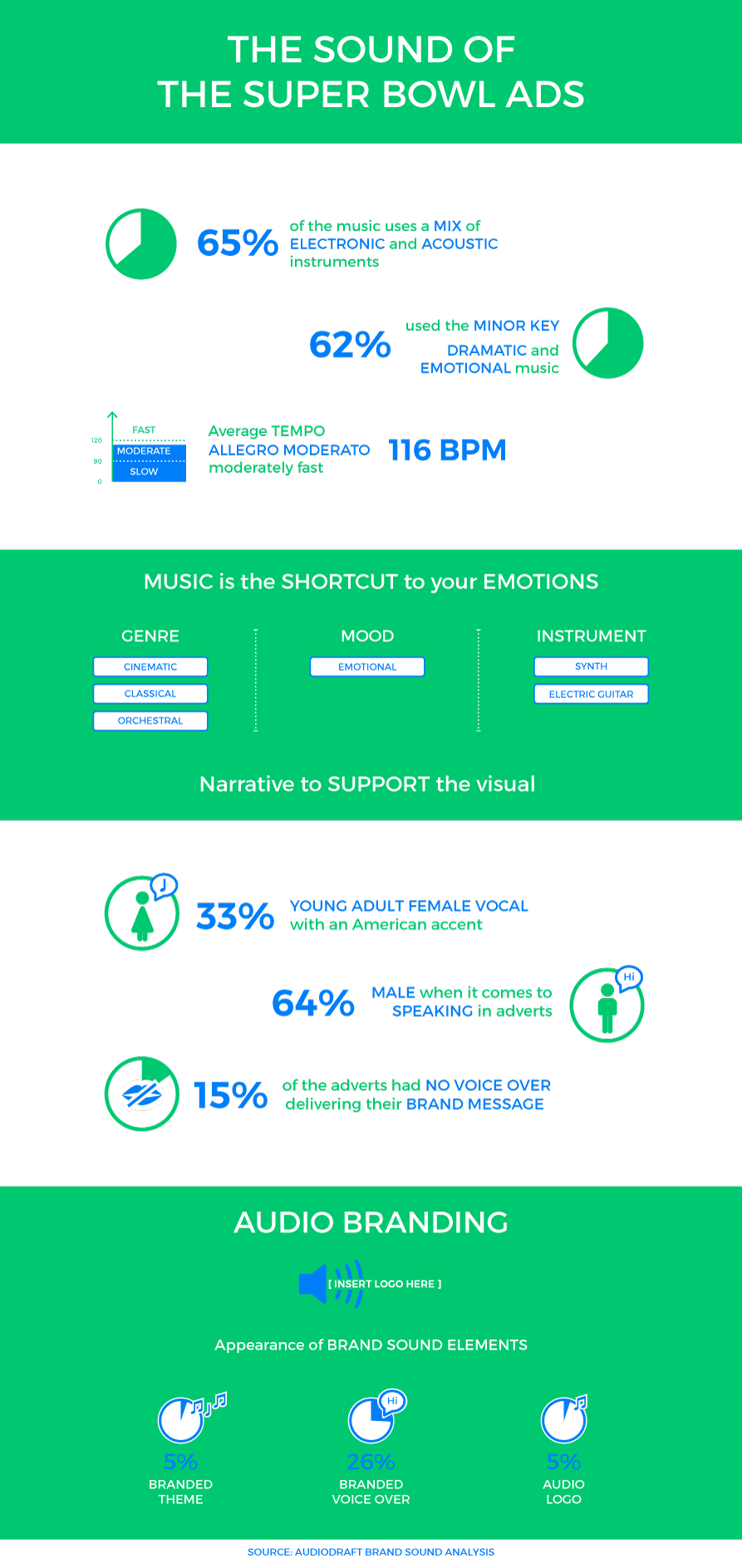Audio Branding – The Sound of the Super Bowl
The Sound of the Super Bowl Ads
Super-Bowl was a spectacular win for the Eagles. They were not the only winners. Amazon’s Alexa gained a staggering amount of publicity with its humorous and irreverent advert which generated a huge volume of brand awareness and interest. We have seen in-depth analysis on the adverts from every angle possible, but one important emerging angle is yet to be covered. Audio Branding. We studied the genre, instrumentation and mood of each adverts music along with the voice overs to bring you a snapshot of the current audio branding tactics at play in this years super bowl spots.
Sound Type
65% of the music uses a mix of electronic and acoustic instruments. Using both traditional and innovative modern instruments is a great way to target the widest audience. Take Squarespace “Make it happen” advert, which seamlessly combines old and new instruments to create something familiar and simple, yet innovative and future-focused, which fits the brands marketing position perfectly.
Songs which use electronic instruments only, target a younger demographic, this is used in adverts with a similar audience, for example, “Groove” by Diet Coke.
Key
62% of adverts used the minor key, which is associated with dramatic and emotional music. In this year’s adverts, the two main tactics of advertisers are to appeal to make you laugh or make you feel. By using dramatic, sentimental or inspiring music, brands hope to connect with us on an emotional level, causing us to better recall their marketing message.
Genre
We see a heavy use of cinematic, classical and orchestral genres. These genres are used as a narrative to support the visuals and add a layer of emotion that pictures alone can not capture. Compositions in these genres target your heartstrings or trigger your adrenaline glands.
Pop and acoustic genres appear quite often. These genres convey a more down to earth, safe and relatable brand image.
Moods
The moods most commonly used to describe the music in these adverts is “emotional”. Music is the shortcut to your emotions, so by using sentimental or adrenaline packed music, the industry is emotionally engaging consumers to increase their recall. The same can be said for the moods of happy, adventurous and inspiring.
Instrumentation
Synth is king. It is the most versatile of all the instruments as it is able to synthetically reproduce almost every sound out there. Synths are used to pad out compositions, create SFX and can even take the lead melody.
The second most popular instrument is the electric guitar, which is a raw powerful and edgy instrument, which appeals to the main demographic of the Super-Bowl, young to middle age males.
Vocals in Songs
The brands which are appealing to emotion, use young, female voices. Brands that use female vocals are often perceived as being gentle, caring, understanding and sincere. The surprise this year is Budweiser using this tactic, as in previous years they have adopted a harder, more male choice of sounds in their productions.
Spoken Word
Audio is not all about music. One of the most interesting takeaways from this years Super-Bowl adverts is that 15% of brands had no voice over delivering their message. Companies like Weather-Tech, Kia and Michelob used music only in their adverts.
Spoken Word Genders
The majority of brands use a young female for their lyrics. When it comes to delivering branded messages, young males are the most popular choice. A recent Studies found that men are more likely to listen to men when it comes to a decision like buying a car or a computer. To get their message heard, advertisers use a voice which speaks on a friend to friend basis with their audience.
Branded Sound Elements
28% of adverts featured branded Voice-over, for example, Doritos and Mountain dew, or David Harbour for Tide. The use of a branded voice-over gives brands a greater sense of consistency between adverts and increases brand recognition.
Only 5% of the commercials had a branded theme song or audio logo, which is very low. By using consistent music (This does not mean the same music!) across advertising portfolio, companies can increases brand recognition, recall and consumer trust, the same advantages seen when companies use a consistent visual branding strategy. Studies show that only 17% of companies have an audio branding strategy or guidelines, while 86% have visual branding guidelines.
Cameron Murphy
Production and Community Manager / Audiodraft.com





